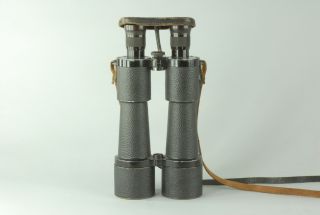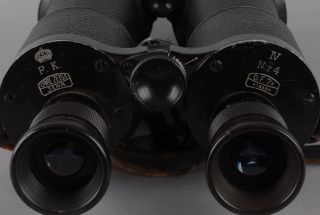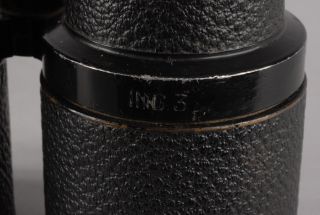Carl Zeiss Jena, D.F. 7x (Abbe-König)»

I think this binocular represents, in a nice way, what I find interesting about military binoculars. The military markings often makes it possible to trace down in which branch the binocular was used, and sometimes in which unit.
First, the binocular itself is hard to find. It was the first 7×50 binocular made by Zeiss. The production started in 1912, perhaps even earlier, and the first of the later more successful Porro 1 7×50, were made in 1915. According to Dr. Seeger less than 1000 pieces of the D.F. 7x and the civilian version, the Noctar, were made.

I found this binocular at an auction in Sweden. On the not too good picture of the binocular in internet, I could see a crown marking. It looked very much like a Swedish big crown, but I was not sure. As I held the binocular in my hands the Swedish crown was confirmed. In my book on page 12 and 20, I mention 15 pieces of D.F. 7X (Abbe-König) binoculars bought by the Swedish navy in 1915. My first thought was that this was a Swedish navy binocular. However the number did not match the numbers of the binoculars bought in 1915; my binocular was made earlier. The number (418 554) indicates that it was produced in 1914. Perhaps it was from a small batch of binoculars bought for test purposes before the larger order was placed?

The binocular was also marked F.K. and IV N:r 4. Swedish navy binoculars are sometimes marked K.F. for Kungliga Flottan (Royal Navy). But the first binoculars I know of marked K.F. are from the 1930´s, so was this an earlier version of the marking and the other way around? I found this very mysterious.
I now started to check what the IV stands for. A Swedish military calendar from 1913, which I have in my library, was consulted. The navy organization was divided in different districts but there were no numbers. However the army had different distrikts,“Armefördelningar”, numbered I, II and so forth. The IV was the area around Stockholm. This seemed to fit; as such an expensive binocular probably was bought only in small numbers for each part of the army. By a closer look I found another marking. On the objective rings was another crown on the left tube and on the right tube: ING 3. Another consultation of the calendar showed that I was on the right track. In the IV army division there was a unit called ING 3 (engineers 3). The unit was also called “Fälttelegraf Kåren”, could the initials F.K. stand for this?
As I read more about this unit I learned that it was responsible for telegraph communications within the army and also the first tests with wireless communications. More interesting to me was the information that this unit also operated the first balloons in the Swedish army. As I knew that Abbe-König-type binoculars were popular among the balloon observers in the German army during the 1:st WW I, felt that was getting closer to a solution of the mystery.
A final information of interest. In 1914 the “Flying” part of this unit was separated from the communication part and also started organizing trails with airplanes. This unit was called “Flyg Kompaniet” and it developed into an army flying corps. My belief is that the initials F.K. on my binocular stands for” Flyg Kompaniet”. If the binocular was used for balloon observations or for observation of airplanes from the ground (or both) I can not say. But I was pleased with my discoveries after this detective effort!
